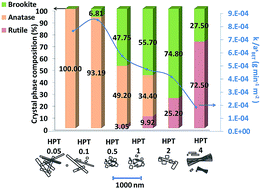New insights into the relationship between structure and photocatalytic properties of TiO2 catalysts†
Abstract
This work systematically investigated the relationship between structure, morphology, photoelectrochemical (PEC) and photocatalytic (PC) properties of TiO2 catalysts. A series of TiO2 catalysts with various phase compositions (anatase-, brookite- and finally rutile-rich samples) and morphologies (1D morphology, rhomboid nanoparticles (NPs) and flower-like assemblies of nanorods) were prepared by an acidic hydrothermal treatment of hydrogen titanate nanofibres (H-TNFs). The structures of the samples, such as crystal phase composition and their spatial distribution, were extensively characterised, and the samples were tested for photocatalytic degradation of ethanol. A strong correlation is found between PEC and PC properties. PEC measurements revealed that the brookite-rich samples generated high but unstable photocurrents. The anatase and rutile-rich samples showed good stability, but for the rutile-rich samples low photocurrents were detected due to the poor conductivity of this polymorph. In contrast, the sample containing 93.2% anatase and 6.8% brookite with elongated morphology not only showed the ability to generate high photocurrents but also maintained a stable photoresponse upon an extended period of time, because of its well-balanced bi-crystalline structure and elongated morphology. Therefore, the abilities to generate high photocurrents and to maintain a stable photoresponse are equally important and probably a prerequisite for a good photocatalyst.


 Please wait while we load your content...
Please wait while we load your content...